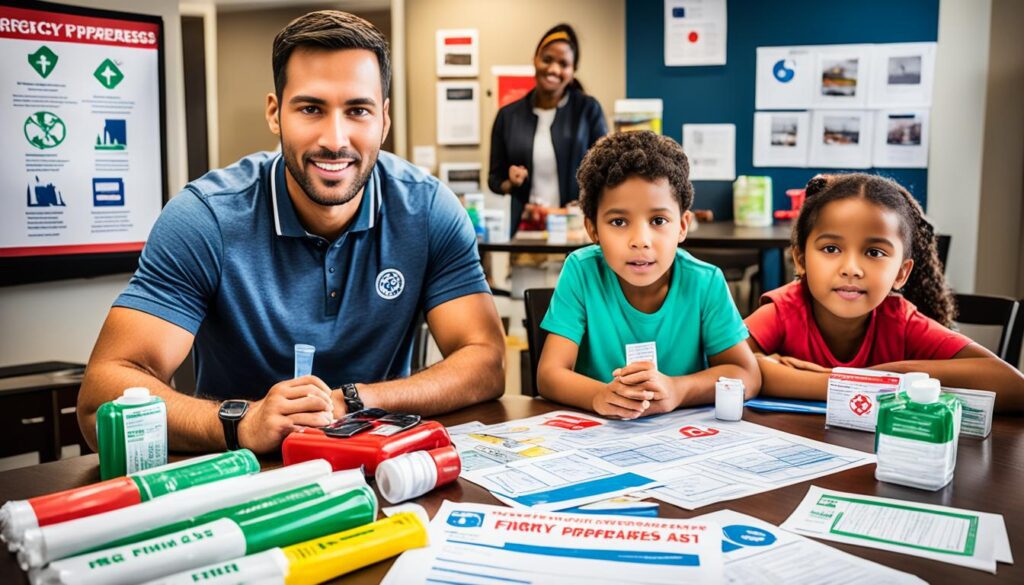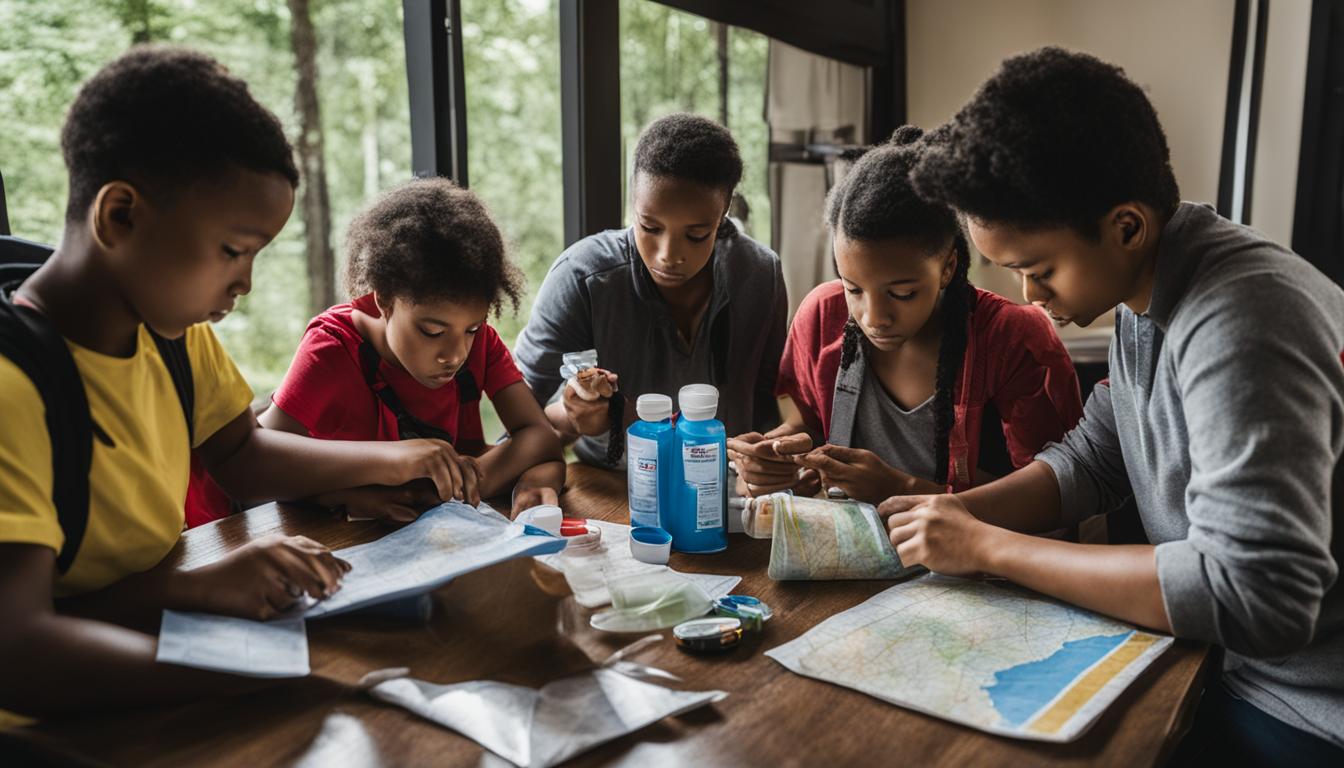An emergency preparedness plan is crucial for effectively managing and responding to crises. It involves knowing what to do before, during, and after an emergency situation. By having a well-thought-out plan in place, you can ensure the safety and readiness of yourself, your family, and your community.
Creating an emergency preparedness plan is essential for staying safe and ready in times of crisis. By following the steps outlined in this article and tailoring your plan to your specific needs, you can be well-prepared to handle emergencies and protect yourself, your loved ones, and your community.
Remember to regularly review and update your plan as needed, and don’t forget to practice your plan with your family or household. With a robust emergency preparedness plan in place, you can have peace of mind knowing that you are ready to face any emergency situation.
Steps to Create an Emergency Preparedness Plan
When it comes to emergency preparedness, having a well-defined plan is essential. By following these steps, you can create a comprehensive emergency preparedness plan that will help you effectively manage and respond to any emergency situation.
Step 1: Identify Potential Risks
Start by identifying the potential risks and disasters that could occur in your area. This can include natural disasters such as hurricanes, earthquakes, floods, or even other emergencies like fires or power outages. By understanding the specific risks you may face, you can tailor your preparedness plan accordingly.
Step 2: Establish a Communication Plan
Communication is crucial during an emergency. Create a communication plan for your family or household that includes how to receive emergency alerts and updates. Determine a designated meeting place and establish alternative methods of communication in case you get separated.
Step 3: Create an Emergency Supply Kit
Ensure you have a well-stocked emergency supply kit that includes essential items. This kit should contain an ample supply of food, water, medications, and first aid supplies. It’s also important to consider the specific needs of your family members, such as infants, elderly individuals, or individuals with medical conditions.
Step 4: Practice Your Plan
Regularly practice your emergency preparedness plan with your family or household members. Conduct drills and simulations to ensure everyone knows what to do in different emergency scenarios. This will help identify any gaps in your plan and allow you to make necessary adjustments.

| Key Steps | Benefits |
|---|---|
| Identify potential risks | Allows you to focus on specific hazards and tailor your plan accordingly |
| Establish a communication plan | Ensures everyone is informed and connected during an emergency |
| Create an emergency supply kit | Provides essential resources and supplies for survival |
| Practice your plan | Increases preparedness and identifies areas that need improvement |
Tailoring Your Plan to Specific Needs
Every household has unique needs and responsibilities that should be taken into account when creating an emergency preparedness plan. Consider factors such as the ages of household members, dietary needs, medical conditions, disabilities, and cultural or religious considerations.
Make sure to incorporate these specific requirements into your plan and gather any necessary supplies or equipment. For example, if you have pets, include provisions for their care and consider pet-friendly shelters or accommodations.
By tailoring your plan to your specific needs, you can ensure that everyone is accounted for and taken care of during an emergency.
Evaluating Household Requirements
When preparing your emergency plan, it’s important to evaluate your household’s unique requirements. Consider the following factors:
- Ages of household members: Ensure that your plan accounts for the needs of children, elderly family members, or anyone with specific medical requirements.
- Dietary needs: Take into consideration any dietary restrictions or preferences when stocking up on emergency food and water supplies.
- Medical conditions: If anyone in your household has a medical condition, ensure that you have the necessary medications and medical equipment readily available.
- Disabilities: Make accommodations and arrangements for anyone with physical or cognitive disabilities to ensure their safety during an emergency.
- Cultural or religious considerations: If your family has specific cultural or religious practices, incorporate them into your emergency plan as needed.
By addressing these unique requirements, you can create a comprehensive emergency preparedness plan that caters to the specific needs of your household.
Pet Considerations
If you have pets, it’s important to include provisions for their care in your emergency plan. Take the following steps to ensure their safety:
- Include pet supplies in your emergency supply kit, such as food, water, medication, and a leash or carrier.
- Identify pet-friendly accommodation options, shelters, or boarding facilities in case you need to evacuate your home.
- Consider microchipping your pets and ensuring their identification tags are up to date.
- Keep a list of important veterinary contacts and medical records for your pets.
Taking these steps will ensure that your furry friends are taken care of during an emergency.

Emergency Evacuation and Sheltering
In the event of an emergency that requires evacuation, it’s essential to have a well-prepared plan in place. By following these key steps, you can ensure the safety and security of yourself and your loved ones.
1. Designate Meeting Places:
Decide on a designated meeting place outside your home in case of a sudden emergency. This location will serve as a central point for everyone to gather and account for each other.
2. Choose a Secondary Location:
In addition to the meeting place outside your home, choose a secondary location outside of your neighborhood. This is crucial in case you cannot return home and need an alternate safe space to go.
3. Establish an Emergency Contact:
Designate an out-of-area emergency contact person who can act as a point of contact for everyone in your household. Ensure that everyone carries their contact information to stay connected during an emergency.
4. Plan for Your Pets:
If you have pets, include provisions for their care in your evacuation plan. Identify pet-friendly accommodations along your evacuation route where you can seek shelter with your furry friends.
5. Practice Evacuation:
Regularly practice evacuating your home at least twice a year. This will help everyone become familiar with the process and identify any areas of improvement in your plan.
6. Familiarize Yourself with Alternate Routes:
It’s important to familiarize yourself with alternate evacuation routes. Keep a printed map of these routes and use GPS units or navigation apps on electronic devices to ensure you can access the most efficient path to safety.

Estimated Time of Evacuation Routes
| Evacuation Route | Estimated Time (in minutes) |
|---|---|
| Route 1 | 30 |
| Route 2 | 25 |
| Route 3 | 40 |
| Route 4 | 35 |
By following these evacuation and sheltering measures, you can be well-prepared to respond effectively in emergency situations. Remember, the safety of yourself and your loved ones should always be the top priority.
Special Considerations for Different Groups
Different groups have unique needs that must be considered when developing an emergency preparedness plan. It is important to address the specific requirements of older adults, people with disabilities, and children to ensure their safety and well-being during an emergency.
Older Adults
When creating an emergency plan for older adults, it is crucial to take into account any mobility issues, medications, and necessary medical equipment. Ensure that there is a plan in place for assistance with transportation and evacuation if needed.
It is also important to have a designated caregiver or emergency contact who can provide support and help coordinate medical needs.
People with Disabilities
People with disabilities require special consideration in an emergency situation. Communication, transportation, and medical support are key factors to address when developing an emergency plan.
Ensure that there are accessible communication methods in place, transportation options that cater to individuals with disabilities, and a plan for acquiring necessary medical supplies or support.
It is also important to have contact information for local disability service organizations that can provide assistance during emergencies.
Children
Families with children should have discussions with their schools and daycare centers to understand the emergency plans in place. It is crucial to ensure that children understand what to do in different emergency scenarios and know who their designated emergency contacts are.
Include age-appropriate explanations and ensure that children have access to any necessary emergency supplies, such as comfort items or medications. Practice emergency drills with children to help them become familiar with the procedures.
By addressing these special considerations for older adults, people with disabilities, and children, you can ensure that your emergency preparedness plan is comprehensive and inclusive. Protecting the safety and well-being of all members of your household is essential during an emergency.
Conclusion
Having an emergency preparedness plan is crucial for ensuring your safety and readiness in times of crisis. By following the steps outlined in this article and tailoring your plan to your specific needs, you can be well-prepared to handle emergencies and protect yourself, your loved ones, and your community.
Remember to regularly review and update your plan as needed to account for any changes in circumstances or new risks that may arise. By staying proactive and vigilant, you can enhance your disaster preparedness and mitigate potential damage.
Don’t forget to practice your emergency procedures with your family or household. This will help everyone become familiar with the plan and ensure that everyone knows what to do in different emergency scenarios. Practice drills can also help identify any gaps or areas for improvement in your plan.
With a robust emergency preparedness plan in place, you can have peace of mind knowing that you are ready to face any emergency situation. By taking the necessary steps to prepare, you are not only safeguarding yourself and your loved ones, but also contributing to the overall safety and resilience of your community.
FAQs
Why is an emergency preparedness plan important?
An emergency preparedness plan is crucial for effectively managing and responding to crises. It ensures the safety and readiness of yourself, your family, and your community.
What are the key steps to create an emergency preparedness plan?
The key steps include identifying potential risks, establishing a communication plan, creating an emergency supply kit, and practicing the plan with your family or household.
How can I tailor my emergency preparedness plan to my specific needs?
Consider factors such as ages, dietary needs, medical conditions, disabilities, and cultural/religious considerations. Gather necessary supplies and equipment accordingly.
What should I include in my emergency evacuation plan?
Decide on designated meeting places, establish an out-of-area emergency contact, plan for pets, and practice evacuating your home at least twice a year.
What special considerations should I keep in mind for different groups?
Older adults should consider mobility issues and necessary medical equipment. People with disabilities should address communication, transportation, and medical support. Families with children should coordinate with schools and daycare centers.
How often should I review and update my emergency preparedness plan?
Regularly review and update your plan as needed, and don’t forget to practice it with your family or household.









